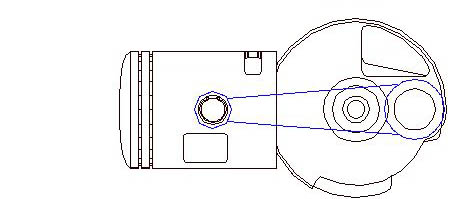Above is a diagram of a P200 crank, con
rod, and piston as viewed from the crank side. The stroke is measured
as the distance from the center of the crank to the center of the crank
pin, then it is multiplied by two to give the full travel. The diagram
above is shown at top dead center (TDC) which shows the furthest extent
of the piston travel towards the head. Bottom dead center (BDC) is
shown below and is the furthest extent of the piston travel towards the
crankcase.

The crank pin is the piece of metal that
holds the con rod to either side of the crank webs. It is usually as
far back from the center of the crank as possible, so there is little
ability to increase the stroke of an existing bike with typical
methods. You can replace the crank pin with an off set pin to increase
the stroke. This involves having a special pin fabricated with a
smaller big end bearing and a different con rod. The area where the con
rod rotates on the crank pin is a smaller diameter than the rest of the
pin so the centers do not align. The center of the smaller pin can be
offset towards the outside of the crank by a few millimeters and allow
you up to about 3mm of stroke increase.
The downside is the cost of the
conversion and the fact that usually a smaller big end bearing means it
will not be as durable.